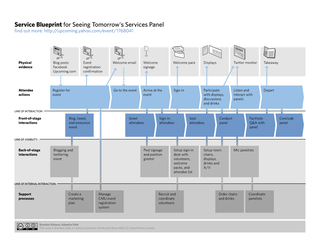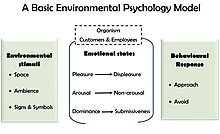Behavior or behaviour is the range of actions and mannerisms made by individuals, organisms, systems or artificial entities in some environment. These systems can include other systems or organisms as well as the inanimate physical environment. It is the computed response of the system or organism to various stimuli or inputs, whether internal or external, conscious or subconscious, overt or covert, and voluntary or involuntary.
The marketing mix is the set of controllable elements or variables that a company uses to influence and meet the needs of its target customers in the most effective and efficient way possible. These variables are often grouped into four key components, often referred to as the "Four Ps of Marketing."

Services marketing is a specialized branch of marketing which emerged as a separate field of study in the early 1980s, following the recognition that the unique characteristics of services required different strategies compared with the marketing of physical goods.

Consumer behaviour is the study of individuals, groups, or organisations and all the activities associated with the purchase, use and disposal of goods and services. Consumer behaviour consists of how the consumer's emotions, attitudes, and preferences affect buying behaviour. Consumer behaviour emerged in the 1940–1950s as a distinct sub-discipline of marketing, but has become an interdisciplinary social science that blends elements from psychology, sociology, social anthropology, anthropology, ethnography, ethnology, marketing, and economics.

Curiosity is a quality related to inquisitive thinking such as exploration, investigation, and learning, evident in humans and animals. Curiosity helps human development, from which derives the process of learning and desire to acquire knowledge and skill.
Service design is the activity of planning and arranging people, infrastructure, communication and material components of a service in order to improve its quality, and the interaction between the service provider and its users. Service design may function as a way to inform changes to an existing service or create a new service entirely.
Salience is the state or condition of being prominent. The Oxford English Dictionary defines salience as "most noticeable or important." The concept is discussed in communication, semiotics, linguistics, sociology, psychology, and political science. It has been studied with respect to interpersonal communication, persuasion, politics, and its influence on mass media.
Affective design describes the design of products, services, and user interfaces that aim to evoke intended emotional responses from consumers, ultimately improving customer satisfaction. It is often regarded within the domain of technology interaction and computing, in which emotional information is communicated to the computer from the user in a natural and comfortable way. The computer processes the emotional information and adapts or responds to try to improve the interaction in some way. The notion of affective design emerged from the field of human–computer interaction (HCI), specifically from the developing area of affective computing. Affective design serves an important role in user experience (UX) as it contributes to the improvement of the user's personal condition in relation to the computing system. Decision-making, brand loyalty, and consumer connections have all been associated with the integration of affective design. The goals of affective design focus on providing users with an optimal, proactive experience. Amongst overlap with several fields, applications of affective design include ambient intelligence, human–robot interaction, and video games.

Once the strategic plan is in place, retail managers turn to the more managerial aspects of planning. A retail mix is devised for the purpose of coordinating day-to-day tactical decisions. The retail marketing mix typically consists of six broad decision layers including product decisions, place decisions, promotion, price, personnel and presentation. The retail mix is loosely based on the marketing mix, but has been expanded and modified in line with the unique needs of the retail context. A number of scholars have argued for an expanded marketing, mix with the inclusion of two new Ps, namely, Personnel and Presentation since these contribute to the customer's unique retail experience and are the principal basis for retail differentiation. Yet other scholars argue that the Retail Format should be included. The modified retail marketing mix that is most commonly cited in textbooks is often called the 6 Ps of retailing.

Visual merchandising is the practice in the retail industry of optimizing the presentation of products and services to better highlight their features and benefits. The purpose of such visual merchandising is to attract, engage, and motivate the customer towards making a purchase.
A touchpoint can be defined as any way consumers can interact with a business organization, whether person-to-person, through a website, an app or any form of communication. When consumers connect with these touchpoints they can consider their perceptions of the business and form an opinion.
Within the study of human behavior, the Low Arousal Approach was developed by Professor Andrew McDonnell in the 1990s, and is now an internationally recognized model of behavior support. A low arousal approach to managing behavior of concern or challenging behavior focuses on stress and well-being, as well as how care givers respond in moments of crisis. Arousal refers to physiological arousal in response to stress, as opposed to sexual arousal. A low arousal approach to supporting individuals with additional needs aims to avoid confrontational situations and instead walk the path of least resistance.
Customer experience is the totality of cognitive, affective, sensory, and behavioral customer responses during all stages of the consumption process including pre-purchase, consumption, and post-purchase stages.
Excitation-transfer theory, based heavily on psychology, psychophysiology, and biochemistry, is a psychological theory that originated in the field of social psychology and effects studies pertaining to communication. In the context of communication, this theory suggests that the emotional response to a particular message or stimulus can be influenced by the residual, or remaining, arousal from a previous experience. Excitation-transfer theory was first proposed by Dolf Zillmann in the 1970s to explain the emotional and physiological processes involved in the transfer of arousal from one situation to another.
Experiential interior design (EID) is the practice of employing experiential or phenomenological values in interior experience design. EID is a human-centered design approach to interior architecture based on modern environmental psychology emphasizing human experiential needs. The notion of EID emphasizes the influence of the designed environments on human total experiences including sensorial, cognitive, emotional, social, and behavioral experiences triggered by environmental cues. One of the key promises of EID is to offer values beyond the functional or mechanical experiences afforded by the environment.

The service blueprint is an applied process chart which shows the service delivery process from the customer's perspective. The service blueprint is one of the most widely used tools to manage service operations, service design and service.
Sensory branding is a type of marketing that appeals to all the senses in relation to the brand. It uses the senses to relate with customers on an emotional level. It is believed that the difference between an ordinary product and a captivating product is emotion. When emotion flows in the marketplace, your product shines. When there is no emotion from the product, customers lack the enthusiasm and passion that launches a product to success. Brands can forge emotional associations in the customers' minds by appealing to their senses. A multi-sensory brand experience generates certain beliefs, feelings, thoughts and opinions to create a brandgon image in the consumer's mind.
Subliminal stimuli are any sensory stimuli below an individual's threshold for conscious perception, in contrast to supraliminal stimuli.

Sexual arousal describes the physiological and psychological responses in preparation for sexual intercourse or when exposed to sexual stimuli. A number of physiological responses occur in the body and mind as preparation for sexual intercourse, and continue during intercourse. Male arousal will lead to an erection, and in female arousal, the body's response is engorged sexual tissues such as nipples, clitoris, vaginal walls, and vaginal lubrication.
Dwayne D. Gremler is a social scientist, academic, and author. He is a Professor of Marketing, Distinguished Teaching Professor, and Distinguished Research Professor in the Schmidthorst College of Business at Bowling Green State University. He is a co-author of the textbook Services Marketing: Integrating Customer Focus Across the Firm, now in its 8th edition.















